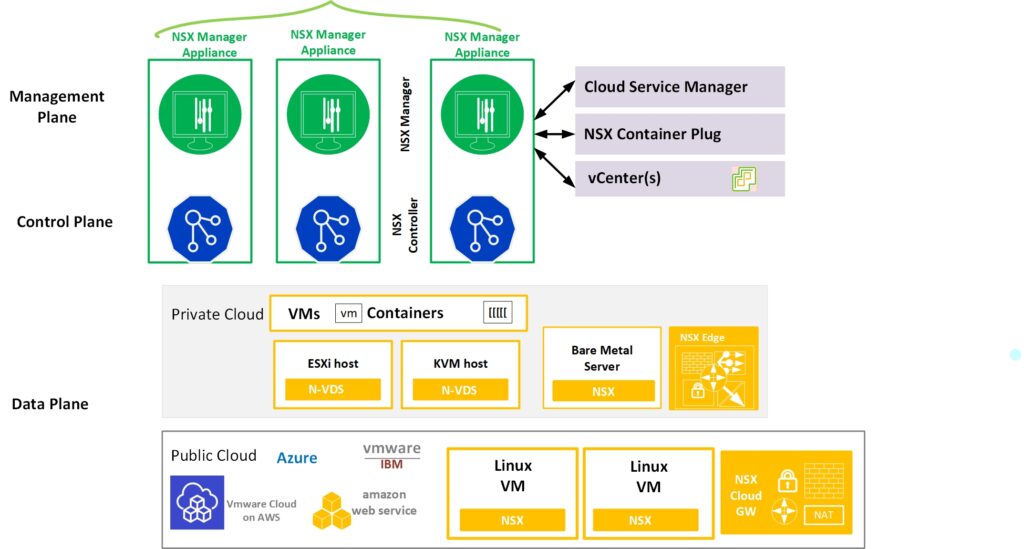In 2013 VMware came up with the NSX-V (Network Security Virtualization Platform) product it’s kind of SDN product that was a success. The Software-Defined Networking (SDN) market with software-defined networking underlying hardware infrastructure is communicated with by software-based controllers or Application Programming Interfaces (APIs) that control network traffic. In this article will discuss Introduction to VMware NSX-T and Its Components.
Overview of VMware NSX-T
The VMware NSX networking framework provides a fully functional L2-L7 overlay virtual network on top of general-purpose IP network hardware in VMware’s Software-Defined Data Center architecture.
Here “Software-Defined Data Center” refers to products /solutions allowing users to control their dynamic computing, storage, and networking resources via an API-driven orchestration system.
VMware NSX-V network virtualization platform is a key part of Software Defined Data Center (SDDC) architecture and brings networking functionality to virtualization.
VMware NSX-T (Transformers) platform provides support for applications that have heterogeneous endpoints and technology stacks.
The idea of NSX is to provide Logical switching, Logical routing, Firewalling and Security, load balancing all these services into the software.
NSX has capabilities to provide Software-based network virtualization, software-based overlay like Virtual Extensible LAN (VXLAN), Distributed routing, Distributed firewalling & API-driven automation.
NSX-V was tightly integrated with the vSphere environment. So NSX-V can’t run on other hypervisors as well. So, VMware has a focus to extend the NSX Product to run at all hypervisors, public cloud, and Software-defined Wide Area Networks (SD-WAN) as well.
So, VMware wants to decouple NSX from the hypervisor & they want to make it very generic.
VMware NSX-T
NSX-T is focusing mainly on below 2 major environments.
Security NSX Data Center. It is an On-prem data center that maintains Networking and security for data center workloads
Integration NSX Cloud. networking and security for public cloud workloads which could be like AWS, Microsoft Azure, or Google Cloud Platform.
These 3 products also work with NSX-T
- Extensibility – App Defense Modern application security.
- Automation – NSX SD-WAN by Velo cloud WAN connectivity services.
- Elasticity – NSX Hybrid Connect datacenter and cloud workload migration.
Key Concepts:
- NSX-V completely focused on ESXi based hypervisor and very limited to ESXi based deployment.
- NSX-T has the capability of supporting any Hypervisor – ESX, KVM
- Heterogenous endpoints: Container, VM, Bare-Metal.
- Multiple Clouds -On-Premises, Hybrid, Public (AWS, Microsoft Azure)
- It also gives, VPN, Load Balancing, Firewalling, DHCP, NAT, and Connectivity to physical.
NSX-T Components:
Data Plane:
In NSX-V data plane resides in ESXi hosts. In NSX-T we can see we have VMs, KVM host, Containers, BareMetal servers, ESXi these are On-Premises deployments & NSX Edge.
the portfolio has increased from NSX-V to NSX-T only one ESXi has capable of giving the services now another environment comes into the picture and contributes to the data plane
Control Plane:
It remains the same as NSX-V. Controllers reside on the control plane
Management Plane:
NSX-V the deployment of the manager and controller are 2 different VMs but in NSX-T it has combined (NSX manager & NSX controller) into a single VM.
In NSX-V there is no clustering feature for NSX manager because it is deployed as a single VM, but NSX-T deployed NSX-T manager as a three-node cluster.
You can also visit VMware’s official site for NSX-Intelligence concept.
vSphere Lifecycle Manager for NSX-T
Using VMware vSphere Lifecycle Manager for ESXi, make ensure that all ESXi hosts in a cluster are prepared using the same ESXi image and the same NSX-T image.
Using vSphere Lifecycle Manager functionality reduces cluster and host maintenance cycles while minimizing errors.
From vCenter Server 7.0 U1, ESXi 7.0 U1, and NSX-T 3.1.0 onward, a vSphere Lifecycle Manager-enabled cluster can manage ESXi and NSX-T VIB (vSphere Installation Bundle) installation.
Summary:
New VMware NSX-V deployments were no longer supported by VMware after 16 January 2022.VMware and IBM worked together to extend the NSX-V support until 31 December 2023 for existing VMware vCenter Server with NSX-V instances. The support for the existing VMware vCenter Server with NSX-V instances will end on 21 June 2022. It is necessary to migrate your NSX-V-enabled vCenter Server to NSX-T. Most of the key concepts we covered about Introduction to VMware NSX-T and Its Components.
In my previous installation and configuration of NSX-T datacenter on VMware vCenter Server.


